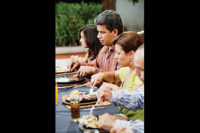![]()
Hispanics
There’s more to targeting this fast-growing
segment than adding a dash of spice to candy formulations and throwing up
some Spanish-language signage in the store.
If you want to do a good job
of targeting Hispanic candy consumers, then you’ve got to have a good
understanding of the concept of acculturation. Acculturation is a term used
to describe the extent to which ethnic consumers have adapted to new
cultural patterns while maintaining values and perspectives from their
native culture.
How acculturated ethnic consumers are relates mostly to
how long they’ve been here. As of 2002, about 44 percent of U.S.
Hispanic consumers were foreign-born, 30 percent were second-generation
U.S. residents, and 26 percent were third-generation, reports David Morse,
president and CEO of New American Dimensions, a Los Angeles-based ethnic
marketing company.
Morse explains that a consumer’s acculturation
level affects shopping patterns, with less acculturated Hispanics shopping
more frequently in non-mainstream retail outlets. “They’re
going to the butcher, the baker, and the produce store; they’re going
to a lot of traditional neighborhood markets,” says Morse.
Which means that a candy maker targeting Hispanics and
first-generation Hispanics, in particular, must carefully evaluate its
distribution strategy in order to “hook up with the distributors that
are getting into these channels,” says Morse.
“As a company, you have to answer to the
different generations,” says Carlos Nava, president of Irving,
Texas-based Montes USA, the U.S. division of a Mexico-based candy maker.
“We find that the first generation seems to respond better to the
brands from home—the brands they grew up with,” says Nava.
But, in order to address the preferences of the more
acculturated, U.S.-born Hispanics, “you may want to look at creating
new brands directly targeting the second and third gener-ation,” Nava
continues.
“Generational” positioning also is very
much a consideration for Lorena USA, a Los Angeles-based subsidiary of
Mexican candy maker Grupo Lorena, explains Octavio Flores, managing
director for Lorena USA.
The company is currently launching a product line
designed to appeal to both “Latinos with more Americanized palates
and non-Latinos with a taste for Latin flavors.” This line of candies
is milk-based and features flavor profiles such as dulce de cajeta (which
is akin to caramel).
Meanwhile for first- and some second-generation
Mexican- Americans, Lorena USA’s focus will be on candies with strong
tropical flavors and spicy accents.
A consumer’s acculturation level affects how he or she
feels about the use of Spanish on packaging.
“The first generation consumer will prefer
Spanish, but the second and third may have switched to English,” says
Nava.
Morse cites research that shows that 80 percent of
Hispanics described as “unacculturated” prefer bilingual
packaging. Although some acculturated Hispanics consider the use of Spanish
offensive or unnecessary, Morse says a recent study found that 40 percent
of acculturated Hispanics also rated it as “very important.” n
Merchandising Mandates
Be willing to modify your approach at retail to capitalize
on the opportunities that present themselves. At Montes USA, marketers have
found that taking candy that might ordinarily be sold packaged and instead merchandising
it in bulk displays in the produce section is an effective strategy. The produce
and meat departments are primary shopping trip destinations for Hispanics, so
it pays to target them there, says Carlos Nava, president of Montes USA, Irving,
Texas.
Don’t neglect the bilingual signage in stores where the demographics warrant it. Consider establishing Hispanic merchandise aisles. "I think it’s all part of an opportunity for retailers to say to the Hispanic consumer, ‘You’re welcome here. We want you here,’" says Nava.
Hispanic consumers are event-driven, so tie marketing/merchandising initiatives into key social and cultural events in the Hispanic community, events such as fiestas and, of course, Cinco de Mayo celebrations.
Don’t be limited by the conventional wisdom that Hispanics are value shoppers. "Sometimes that gets played out more than needed," says Nava. "We’ve found that if it’s high-quality product in a nice package, you don’t necessarily have to price it at 99 cents. We sell a lot of products [in larger package sizes] in the $5, $6 and $7 range." Octavio Flores of Lorena USA agrees. He notes that an Hispanic consumer may be "willing to pay even more to get something that will remind them of home."
Don’t neglect the bilingual signage in stores where the demographics warrant it. Consider establishing Hispanic merchandise aisles. "I think it’s all part of an opportunity for retailers to say to the Hispanic consumer, ‘You’re welcome here. We want you here,’" says Nava.
Hispanic consumers are event-driven, so tie marketing/merchandising initiatives into key social and cultural events in the Hispanic community, events such as fiestas and, of course, Cinco de Mayo celebrations.
Don’t be limited by the conventional wisdom that Hispanics are value shoppers. "Sometimes that gets played out more than needed," says Nava. "We’ve found that if it’s high-quality product in a nice package, you don’t necessarily have to price it at 99 cents. We sell a lot of products [in larger package sizes] in the $5, $6 and $7 range." Octavio Flores of Lorena USA agrees. He notes that an Hispanic consumer may be "willing to pay even more to get something that will remind them of home."
Measuring the Market
Population Size: 37.4 million
Percent of the Population: 13.3%
Percent Growth Forecast by 2010: 34.1%
SOURCE: U.S. CENSUS BUREAU
Percent of the Population: 13.3%
Percent Growth Forecast by 2010: 34.1%
SOURCE: U.S. CENSUS BUREAU
| Hispanic Candy Penetration in Los Angeles (A look at candy penetration in Hispanic households vs. mainstream) | |||
| Candy Category | Overall Population | Non-Hispanic Households | Hispanic Households |
| Breath Sweeteners | 29.9 | 33.0 | 23.2 |
| Chocolate | 77.6 | 84.9 | 62.1 |
| Non-Chocolate | 74.7 | 79.6 | 64.3 |
| Total Candy | 91.4 | 95.4 | 82.8 |


